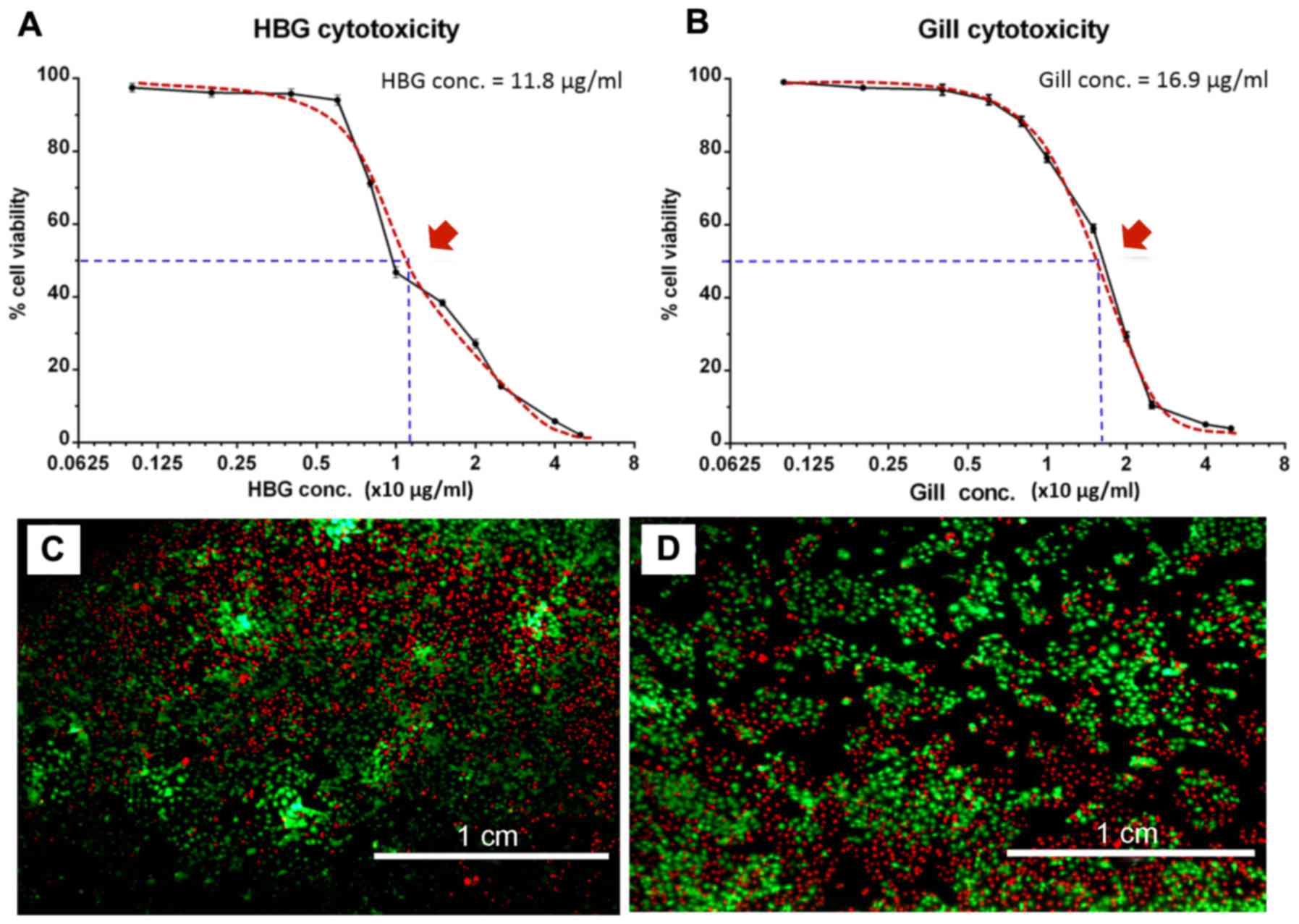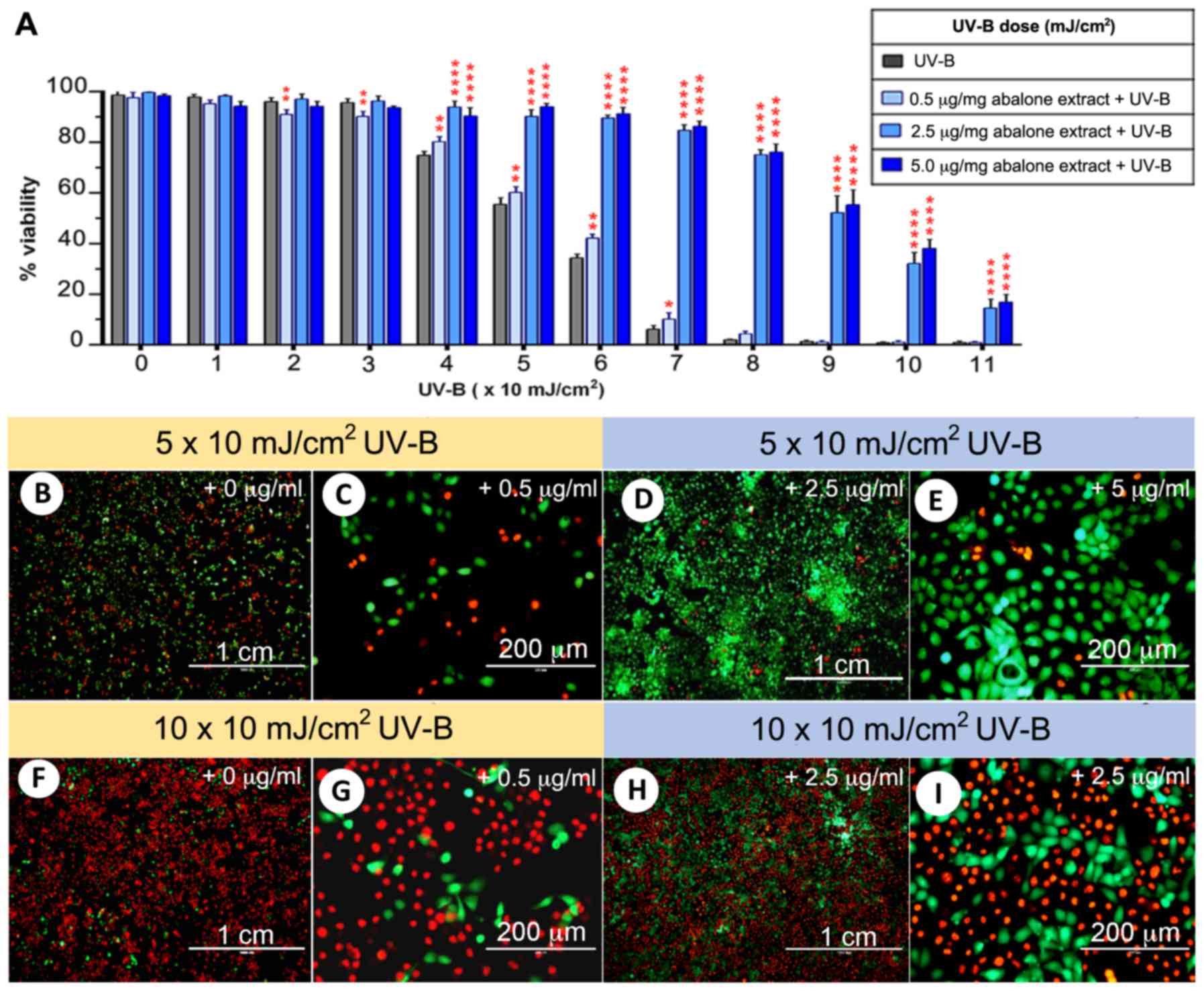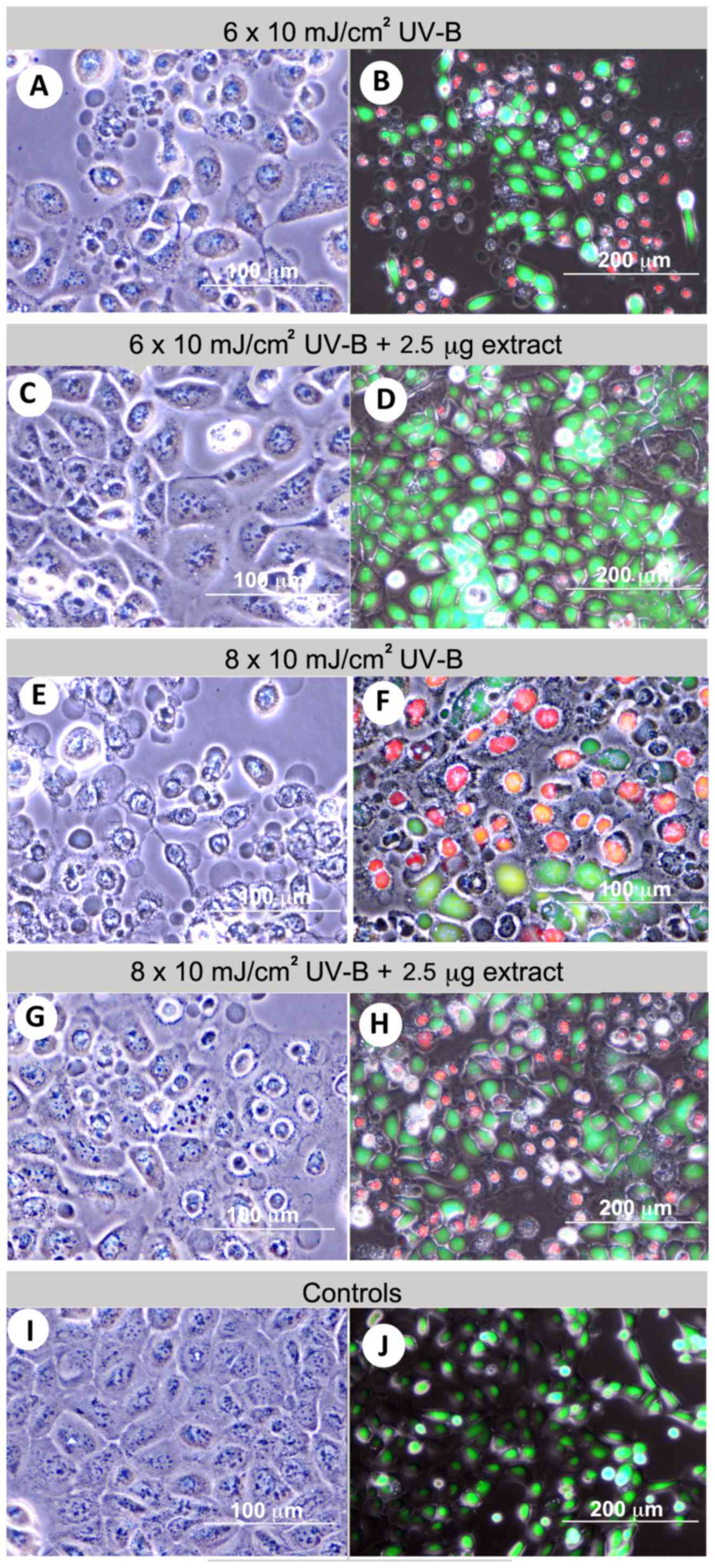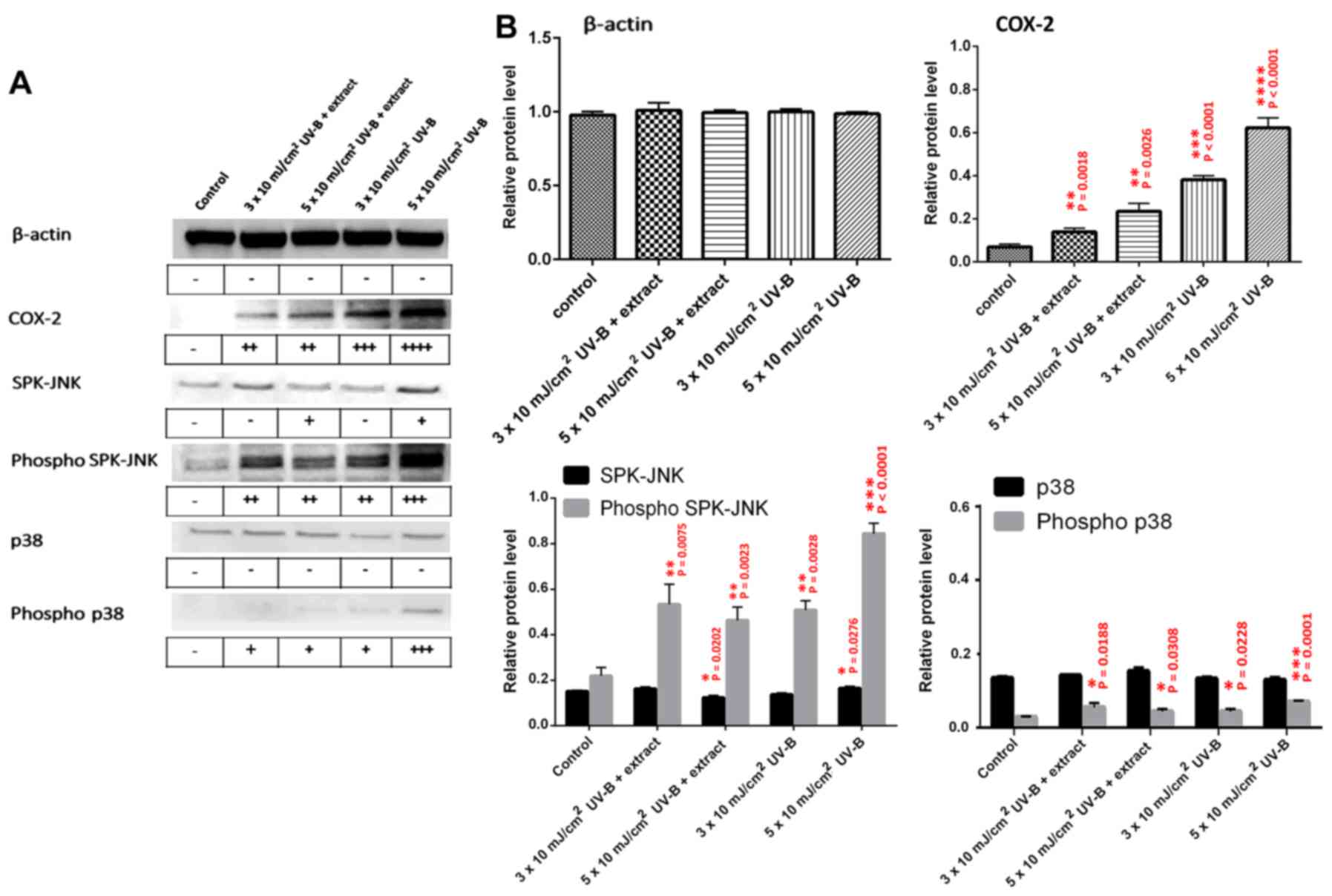|
1
|
de Gruijl FR and Van der Leun JC: Estimate
of the wavelength dependency of ultraviolet carcinogenesis in
humans and its relevance to the risk assessment of a stratospheric
ozone depletion. Health Phys. 67:319–325. 1994. View Article : Google Scholar : PubMed/NCBI
|
|
2
|
Svobodova A, Walterova D and Vostalova J:
Ultraviolet light induced alteration to the skin. Biomed Pap Med
Fac Univ Palacky Olomouc Czech Repub. 150:25–38. 2006. View Article : Google Scholar : PubMed/NCBI
|
|
3
|
Nichols JA and Katiyar SK: Skin
photoprotection by natural polyphenols: Anti-inflammatory,
antioxidant and DNA repair mechanisms. Arch Dermatol Res.
302:71–83. 2010. View Article : Google Scholar
|
|
4
|
Afaq F: Natural agents: Cellular and
molecular mechanisms of photoprotection. Arch Biochem Biophys.
508:144–151. 2011. View Article : Google Scholar :
|
|
5
|
López-Camarillo C, Ocampo EA, Casamichana
ML, Pérez- Plasencia C, Alvarez-Sánchez E and Marchat LA: Protein
kinases and transcription factors activation in response to
UV-radiation of skin: Implications for carcinogenesis. Int J Mol
Sci. 13:142–172. 2012. View Article : Google Scholar : PubMed/NCBI
|
|
6
|
Bender K, Göttlicher M, Whiteside S,
Rahmsdorf HJ and Herrlich P: Sequential DNA damage-independent and
-dependent activation of NF-kappaB by UV. EMBO J. 17:5170–5181.
1998. View Article : Google Scholar : PubMed/NCBI
|
|
7
|
Hernandez-Pigeon H, Jean C, Charruyer A,
Haure MJ, Titeux M, Tonasso L, Quillet-Mary A, Baudouin C,
Charveron M and Laurent G: Human keratinocytes acquire cellular
cytotoxicity under UV-B irradiation. Implication of granzyme B and
perforin. J Biol Chem. 281:13525–13532. 2006. View Article : Google Scholar : PubMed/NCBI
|
|
8
|
Ali D, Verma A, Mujtaba F, Dwivedi A, Hans
RK and Ray RS: UV-B-induced apoptosis and DNA damaging potential of
chrysene via reactive oxygen species in human keratinocytes.
Toxicol Lett. 204:199–207. 2011. View Article : Google Scholar : PubMed/NCBI
|
|
9
|
Wu MS, Sun DS, Lin YC, Cheng CL, Hung SC,
Chen PK, Yang JH and Chang HH: Nanodiamonds protect skin from
ultraviolet B-induced damage in mice. J Nanobiotechnology.
13:352015. View Article : Google Scholar : PubMed/NCBI
|
|
10
|
Devary Y, Rosette C, DiDonato JA and Karin
M: NF-kappa B activation by ultraviolet light not dependent on a
nuclear signal. Science. 261:1442–1445. 1993. View Article : Google Scholar : PubMed/NCBI
|
|
11
|
Buckman SY, Gresham A, Hale P, Hruza G,
Anast J, Masferrer J and Pentland AP: COX-2 expression is induced
by UV-B exposure in human skin: Implications for the development of
skin cancer. Carcinogenesis. 19:723–729. 1998. View Article : Google Scholar : PubMed/NCBI
|
|
12
|
Muller-Decker K, Neufang G, Berger I,
Neumann M, Marks F and Furstenberger G: Transgenic cyclooxygenase-2
overexpression sensitizes mouse skin for carcinogenesis. Proc Natl
Acad Sci USA. 99:12483–12488. 2002. View Article : Google Scholar : PubMed/NCBI
|
|
13
|
Shibata A, Nakagawa K, Yamanoi H, Tsuduki
T, Sookwong P, Higuchi O, Kimura F and Miyazawa T: Sulforaphane
suppresses ultraviolet B-induced inflammation in HaCaT
keratinocytes and HR-1 hairless mice. J Nutr Biochem. 21:702–709.
2010. View Article : Google Scholar
|
|
14
|
Liu S, Mizu H and Yamauchi H:
Photoinflammatory responses to UV-irradiated ketoprofen mediated by
the induction of ROS generation, enhancement of cyclooxygenase-2
expression, and regulation of multiple signaling pathways. Free
Radic Biol Med. 48:772–780. 2010. View Article : Google Scholar
|
|
15
|
Kim JE, Kwon JY, Seo SK, Son JE, Jung SK,
Min SY, Hwang MK, Heo YS, Lee KW and Lee HJ: Cyanidin suppresses
ultraviolet B-induced COX-2 expression in epidermal cells by
targeting MKK4, MEK1, and Raf-1. Biochem Pharmacol. 79:1473–1482.
2010. View Article : Google Scholar : PubMed/NCBI
|
|
16
|
Englaro W, Dérijard B, Ortonne JP and
Ballotti R: Solar ultraviolet light activates extracellular
signal-regulated kinases and the ternary complex factor in human
normal keratinocytes. Oncogene. 16:661–664. 1998. View Article : Google Scholar : PubMed/NCBI
|
|
17
|
Ashida M, Bito T, Budiyanto A, Ichihashi M
and Ueda M: Involvement of EGF receptor activation in the induction
of cyclooxygenase-2 in HaCaT keratinocytes after UV-B. Exp
Dermatol. 12:445–452. 2003. View Article : Google Scholar : PubMed/NCBI
|
|
18
|
El-Abaseri TB, Hammiller B, Repertinger SK
and Hansen LA: The epidermal growth factor receptor increases
cytokine production and cutaneous inflammation in response to
ultraviolet irradiation. ISRN Dermatol. 2013:8487052013. View Article : Google Scholar : PubMed/NCBI
|
|
19
|
Zamzow JP and Losey GS: Ultraviolet
radiation absorbance by coral reef fish mucus: Photo-protection and
visual communication. Environ Biol Fishes. 63:41–47. 2002.
View Article : Google Scholar
|
|
20
|
Jacobson PB and Jacobs RS: Fuscoside: An
anti-inflammatory marine natural product which selectively inhibits
5-lipoxygenase Part I: Physiological and biochemical studies in
murine inflammatory models. J Pharmacol Exp Ther. 262:866–873.
1992.PubMed/NCBI
|
|
21
|
Ojika M, Kigoshi H, Yoshida Y, Ishigaki T,
Nisiwaki M, Tsukada I, Arakawa M, Ekimoto H and Yamada K:
Aplyronine A, a potent antitumor macrolide of marine origin, and
the congeners aplyronines B and C: Isolation, structures, and
bioactivities. Tetrahedron. 63:3138–3167. 2007. View Article : Google Scholar
|
|
22
|
Uddin MH, Otsuka M, Muroi T, Ono A, Hanif
N, Matsuda S, Higa T and Tanaka J: Deoxymanoalides from the
nudibranch Chromodoris willani. Chem Pharm Bull (Tokyo).
57:885–887. 2009. View Article : Google Scholar
|
|
23
|
Yamada K, Ojika M, Kigoshi H and Suenaga
K: Aplyronine A, a potent antitumor macrolide of marine origin, and
the congeners aplyronines B-H: Chemistry and biology. Nat Prod Rep.
26:27–43. 2009. View
Article : Google Scholar : PubMed/NCBI
|
|
24
|
Adikwu MU and Alozie BU: Application of
snail mucin dispersed in detarium gum gel in wound healing. Sci Res
Essays. 2:195–198. 2007.
|
|
25
|
Santana WA, Melo CM, Cardoso JC,
Pereira-Filho RN, Rabelo AS, Reis FP and Albuquerque-Júnior RLC:
Assessment of antimicrobial activity and healing potential of
mucous secretion of Achatina fulica. Int J Morphol. 30:365–373.
2012. View Article : Google Scholar
|
|
26
|
Shimidzu N, Goto M and Miki W: Carotenoids
as singlet oxygen quenchers in marine organisms. Fish Sci.
62:134–137. 1996.
|
|
27
|
Bonnemain B: Helix and drugs: Snails for
western health care from antiquity to the present. Evid Based
Complement Alternat Med : eCAM. 2:25–28. 2005. View Article : Google Scholar : PubMed/NCBI
|
|
28
|
D'Orazio N, Gammone MA, Gemello E, De
Girolamo M, Cusenza S and Riccioni G: Marine bioactives:
Pharmacological properties and potential applications against
inflammatory diseases. Mar Drugs. 10:812–833. 2012. View Article : Google Scholar : PubMed/NCBI
|
|
29
|
Cruz MC, Sanz-Rodríguez F, Zamarrón A,
Reyes E, Carrasco E, González S and Juarranz A: A secretion of the
mollusc Cryptomphalus aspersa promotes proliferation, migration and
survival of keratinocytes and dermal fibroblasts in vitro. Int J
Cosmet Sci. 34:183–189. 2012. View Article : Google Scholar
|
|
30
|
Chalermwat K, Szuster BW and Flaherty M:
Shellfish aquaculture in Thailand. Aquac Econ Manag. 7:249–261.
2003. View Article : Google Scholar
|
|
31
|
Cook PA and Roy Gordon H: World abalone
supply, markets, and pricing. J Shellfish Res. 29:569–571. 2010.
View Article : Google Scholar
|
|
32
|
Wanichanon C, Laimek P, Linthong V,
Sretarugsa P, Kruatrachue M, Upatham ES, Poomtong T and Sobhon P:
Histology of hypobranchial glands and gills of Haliotis asinina
Linnaeus. J Shellfish Res. 23:1107–1112. 2004.
|
|
33
|
Naegel LCA and Aguilar-Cruz CA: The
hypobranchial gland from the purple snail Plicopurpura pansa
(Gould, 1853) (Prosobranchia: Muricidae). J Shellfish Res.
25:391–394. 2006. View Article : Google Scholar
|
|
34
|
Laimek P, Clark S, Stewart M, Pfeffer F,
Wanichanon C, Hanna P and Sobhon P: The presence of GABA in
gastropod mucus and its role in inducing larval settlement. J Exp
Mar Biol Ecol. 354:182–191. 2008. View Article : Google Scholar
|
|
35
|
Kuanpradit C, Cummins SF, Degnan BM,
Sretarugsa P, Hanna PJ, Sobhon P and Chavadej J: Identification of
an attractin-like pheromone in the mucus-secreting hypobranchial
gland of the abalone Haliotis asinina linnaeus. J Shellfish Res.
29:699–704. 2010. View Article : Google Scholar
|
|
36
|
Kuanpradit C, Stewart MJ, York PS, Degnan
BM, Sobhon P, Hanna PJ, Chavadej J and Cummins SF: Characterization
of mucus-associated proteins from abalone (Haliotis) - candidates
for chemical signaling. FEBS J. 279:437–450. 2012. View Article : Google Scholar
|
|
37
|
Stewart P, Williams EA, Stewart MJ,
Soonklang N, Degnan SM, Cummins SF, Hanna PJ and Sobhon P:
Characterization of a GABAA receptor β subunit in the abalone
Haliotis asinina that is upregulated during larval development. J
Exp Mar Biol Ecol. 410:53–60. 2011. View Article : Google Scholar
|
|
38
|
Seo MD, Kang TJ, Lee CH, Lee AY and Noh M:
HaCaT keratinocytes and primary epidermal keratinocytes have
different transcriptional profiles of cornified envelope-associated
genes to T helper cell cytokines. Biomol Ther (Seoul). 20:171–176.
2012. View Article : Google Scholar
|
|
39
|
Yang YL, Chang CH, Huang CC and Liu HW:
Anti- inflammation and anti-apoptosis effects of pearl extract gel
on UV-B irradiation HaCaT cells. Biomed Mater Eng. 26(Suppl 1):
S139–S145. 2015.
|
|
40
|
Kim SB, Kang OH, Joung DK, Mun SH, Seo YS,
Cha MR, Ryu SY, Shin DW and Kwon DY: Anti-inflammatory effects of
tectroside on UV-B-induced HaCaT cells. Int J Mol Med.
31:1471–1476. 2013.PubMed/NCBI
|
|
41
|
Al-Nasiry S, Geusens N, Hanssens M, Luyten
C and Pijnenborg R: The use of Alamar Blue assay for quantitative
analysis of viability, migration and invasion of choriocarcinoma
cells. Hum Reprod. 22:1304–1309. 2007. View Article : Google Scholar : PubMed/NCBI
|
|
42
|
Shick JM, Lesser MP, Dunlap WC, Stochaj
WR, Chalker BE and Won JW: Depth dependent responses to solar
ultraviolet radiation and oxidative stress in the zooxanthellate
coral Acropora microphthalma. Mar Biol. 122:41–51. 1995. View Article : Google Scholar
|
|
43
|
Baker KS, Smith RC and Green AES: Middle
ultraviolet radiation reaching the ocean surface. Photochem
Photobiol. 32:367–374. 1980. View Article : Google Scholar
|
|
44
|
Geiger DL: Distribution and biogeography
of the recent Haliotidae (Gastropoda: Vetigastropoda) world-wide.
Bollettino Malacologico. 35:57–120. 2000.
|
|
45
|
Benkendorff K, Rudd D, Nongmaithem BD, Liu
L, Young F, Edwards V, Avila C and Abbott CA: Are the traditional
medical uses of muricidae molluscs substantiated by their
pharmacological properties and bioactive compounds? Mar Drugs.
13:5237–5275. 2015. View Article : Google Scholar : PubMed/NCBI
|
|
46
|
Sales-Campos H, de Souza PR, Basso PJ,
Ramos AD, Nardini V, Chica JE, Capurro ML, Sá-Nunes A and de Barros
Cardoso CR: Aedes aegypti salivary gland extract ameliorates
experimental inflammatory bowel disease. Int Immunopharmacol.
26:13–22. 2015. View Article : Google Scholar : PubMed/NCBI
|
|
47
|
Ghosh M, Sangwan N and Sangwan AK: Partial
characterization of a novel anti-inflammatory protein from salivary
gland extract of Hyalomma anatolicum anatolicum (77Acari: Ixodidae)
ticks. Vet World. 8:772–776. 2015. View Article : Google Scholar
|
|
48
|
Wei L, Huang C, Yang H, Li M, Yang J, Qiao
X, Mu L, Xiong F, Wu J and Xu W: A potent anti-inflammatory peptide
from the salivary glands of horsefly. Parasit Vectors. 8:5562015.
View Article : Google Scholar : PubMed/NCBI
|
|
49
|
Cheong SH, Hwang JW, Lee SH, Kim YS, Sim
EJ, You BI, Lee SH, Park DJ, Ahn CB, Kim EK, et al: In vitro and in
vivo antioxidant and anti-inflammatory activities of abalone
(Haliotis discus) water extract. Adv Exp Med Biol. 803:833–849.
2015. View Article : Google Scholar : PubMed/NCBI
|













